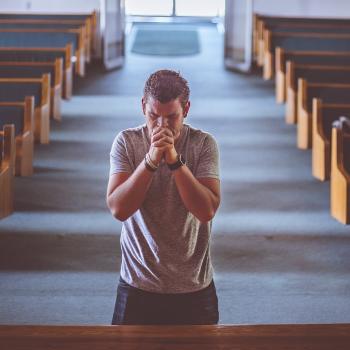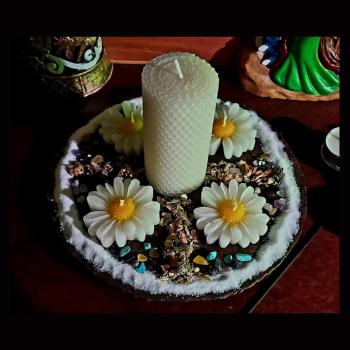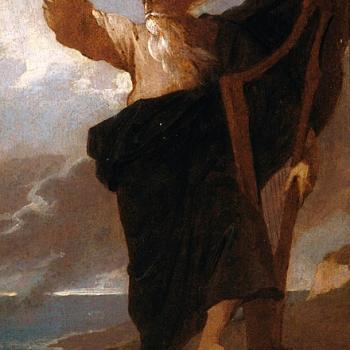Of course, on the human side, we remember that Moses hadn't wanted to be a prophet in the first place and had made excuses to God to get out of it. (If you know what it's like to make excuses to God, you have a little something in common with Moses.) He had given in to the people, when he just couldn't stand their murmuring and complaining and rebelling another second, with the consequence that, while God took him to the top of Mt. Nebo to survey the promised land, he couldn't enter into it. (If you have ever compromised your faith convictions for popular opinion, you have a little something in common with Moses. And if you have ever felt the pain of separation from God because of your actions, you have a little something in common with Moses.) Fearful, making mistakes, yet all in all a great prophet and servant -- maybe there is something there for us! When we admit that, although we are excuse-making, soft-spined servants, we are still chosen and called to leadership we have a lot in common with Moses! Moses knew about both the suffering and the glory and he had come back to tell Jesus about the glory.
I have a really hard time identifying with Elijah, this fearless prophet who, rather than dying like the rest of us, was taken up into heaven in a chariot of fire pulled by horses of fire (2 Kgs 2). Of course, he was the same prophet who, when he found out Queen Jezebel's forces were out to kill him, ran scared, hid out in the hills, and sat under a broom tree, begging for God to take his life. He could take people not listening to him, but he hadn't bargained on their trying to kill him (1 Kgs. 18, 19). (Any of us who have ever said to God, "This is the end of the line. I'm not following anymore. You didn't tell me about this" have a little something in common with Elijah.) From begging for death under a broom tree to being taken up to heaven in a chariot of fire, Elijah knew the agony and the ecstasy, the suffering and the glory. And he had come back to talk to Jesus about the glory. Many people in Jesus' time expected that Elijah would return to signal the coming of the Messiah. And sure enough, on this mountain, he did.
What did these two talk about to a tired and dread- filled Jesus? Luke tells us they discussed Jesus' Exodus from Jerusalem (Lk. 9:31). They told him to view his journey to Jerusalem as an exodus from death to life, like the Red Sea passage, and to view his end in the same way. They reassured him of the glory. They offered him encouragement. Matthew just said they were "talking with him" (Mt. 17:3).
Like Peter, I might have babbled about building them booths or tabernacles to stay forever up on the mountain with me (Mt. 17:4). Perhaps Jesus didn't want them to leave either. I wouldn't presume to say.
But this memory comes to mind. When I was in the throes of a very long labor with my daughter, Rebecca, I remember clinging to the hand of a kindly nurse, who was trying to extricate herself from my grasp. "Give me back my hand now, honey," she said, kindly but firmly. "My shift is over now. I've gotta go home." I allowed her to pry my fingers from her hand. She smiled at me, and said, with that wonderfully practical manner that nurses have: "If one of us has to leave, it better be me. Because you're the only one who can have this baby."
The two prophets' shift is over, leaving Jesus with a job that only he can accomplish. He is the only one who can lead this new Exodus, teach, heal, and challenge all the way to Jerusalem, city of his death, and city of his resurrection.
Now a cloud overshadows Jesus and the others, meant to remind us of the cloud that stood at the door of Moses' tent to mark the Presence of God (Shekinah). The voice speaks from the cloud assuring the disciples of Jesus' divine identity and mission. Then it lifts and Jesus is left alone. With a refreshed sense of his own identity, with the assurance of God's presence in suffering and glory, he gestures to his disciples to fall in behind him and follow him down the mountain.
Peter, James, and John: Identifying with them? James and John perhaps stand there with reverent awe. Perhaps their mouths fall open in undignified shock. Peter embarrasses himself by babbling about building booths. Remember, though, all three of these men become leaders of the early church, and all three die painfully for their faith in their Transfigured Lord.
On the way down the mountain Jesus instructs them not to mention his transfiguration until after his Resurrection. It seems as if they respected his wishes and remained silent. But I suspect they couldn't think of much else for days to come. Like when you stare at the sun for even a moment, and for a long time afterward, when you close your eyes or look at something else, the imprint of that dazzling sun is still before your mind's eye. These three onlookers/babblers, keeping this event before their mind's eye, have their identity transformed by their relationship with Jesus into leaders and courageous martyrs. When you think about it, everybody in the story of the Transfiguration, on top of the mountain, and around the bottom of the mountain, received their identity from the unique identity of Jesus.
Jesus is a unique character in this story and in all stories. He is a character with whom we can identify in his humanity. He is a character who identifies with us in his divinity. In him we behold what we want to become. In us he lives as a presence that empowers us to become what God would have us become. As the Apostle Paul says, "All of us, with unveiled faces, seeing the glory of the Lord as though reflected in a mirror, are being transformed into the same image from one degree of glory to another, for this comes from the Lord, the Spirit" (2 Cor. 3:18).





